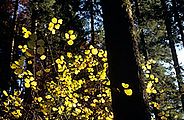En forêt, la capacité des arbres à concurrencer leurs voisins est déterminée par certaines caractéristiques fonctionnelles. Celles-ci sont universelles dans tous les écosystèmes forestiers à travers le monde, conclut une étude publiée aujourd'hui dans la revue Nature.

(Ce texte n'est disponible qu'en anglais)
An international team of researchers has revealed that three functional traits – wood density, specific leaf area and maximum height – affect competition in predictable ways across all forested biomes worldwide. "This is the first time that we were able to verify key drivers of forest succession globally," explains co-author Niklaus Zimmermann from the Swiss Federal Institute for Forest, Snow and Landscape Research WSL.
Competition between neighbouring trees has a big impact on their growth. Trees have different strategies to deal with competing neighbours. Some grow quickly and tall, overshadowing the others, but die young. Others grow more slowly, but outlive the fast growing ones and cast shade on them over a longer period. These interactions have a strong influence on the dynamics of forests and their functioning as ecosystems.
Predicting competition
Forests are crucial elements of the earth system, also for humanity, stretching across ecosystems from boreal regions to the tropics. Therefore, ecologists have long sought an approach that might allow competition to be predicted in a general way across ecosystems and the tens of thousands of different tree species worldwide.
The research published in Nature achieved this via so-called "functional traits" of species – wood density, specific leaf area (SLA, area per unit dry mass of leaf) and maximum height. Trees differ in these traits in a consistent way. Poplar and birch trees are light demanding species and exhibit comparably high SLA, meaning that their leaves let a lot of light shine through, while beech trees possess thicker leaves, exhibit lower SLA and are thus more shade tolerant. Poplar and birch grow fast, tall and have lower wood density, while beech trees grow more slowly and with higher wood density.
Tree traits determine to what degree a central tree is affected by neighbouring trees and to what degree it casts an effect on its neighbours’ growth. "These traits affect competition independent of the ecosystem, region or species identity," explains the WSL’s Niklaus Zimmermann. According to the new research functional traits can provide a foundation for predicting dynamics and interactions between plant species on earth.
For this study a team of almost 40 researchers brought together national forest inventory and research plot data spanning 3 million trees in over 140,000 plots across the world. Marc Hanewinkel and Niklaus Zimmermann from the Swiss Federal Institute for Forest, Snow and Landscape Research WSL contributed data from the Swiss National Forest Inventory NFI, which surveys changes of Swiss forest on roughly 6500 plots.
